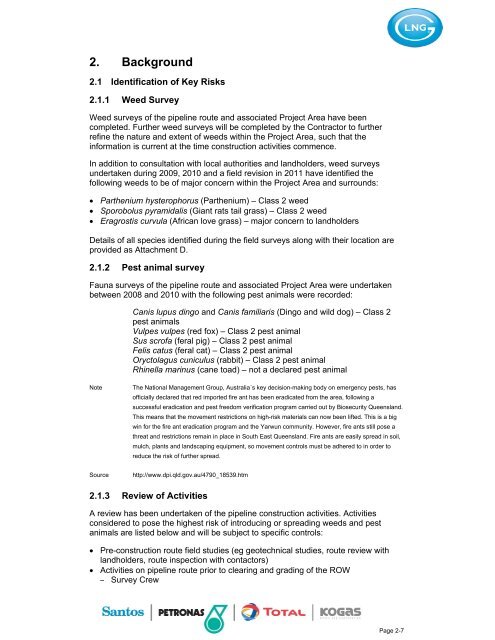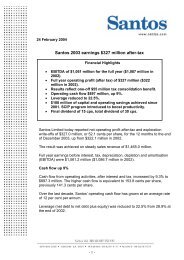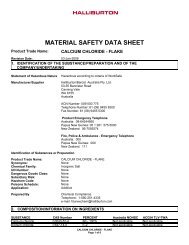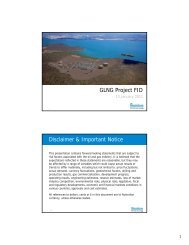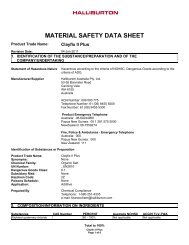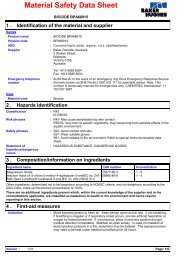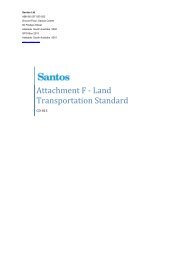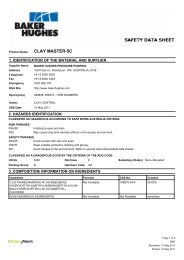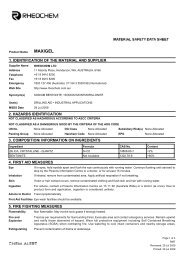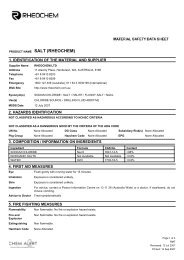Appendix B – Pest and Weed Management Plan (5 MB) - Santos
Appendix B – Pest and Weed Management Plan (5 MB) - Santos
Appendix B – Pest and Weed Management Plan (5 MB) - Santos
Create successful ePaper yourself
Turn your PDF publications into a flip-book with our unique Google optimized e-Paper software.
2. Background<br />
2.1 Identification of Key Risks<br />
2.1.1 <strong>Weed</strong> Survey<br />
<strong>Weed</strong> surveys of the pipeline route <strong>and</strong> associated Project Area have been<br />
completed. Further weed surveys will be completed by the Contractor to further<br />
refine the nature <strong>and</strong> extent of weeds within the Project Area, such that the<br />
information is current at the time construction activities commence.<br />
In addition to consultation with local authorities <strong>and</strong> l<strong>and</strong>holders, weed surveys<br />
undertaken during 2009, 2010 <strong>and</strong> a field revision in 2011 have identified the<br />
following weeds to be of major concern within the Project Area <strong>and</strong> surrounds:<br />
• Parthenium hysterophorus (Parthenium) <strong>–</strong> Class 2 weed<br />
• Sporobolus pyramidalis (Giant rats tail grass) <strong>–</strong> Class 2 weed<br />
• Eragrostis curvula (African love grass) <strong>–</strong> major concern to l<strong>and</strong>holders<br />
Details of all species identified during the field surveys along with their location are<br />
provided as Attachment D.<br />
2.1.2 <strong>Pest</strong> animal survey<br />
Fauna surveys of the pipeline route <strong>and</strong> associated Project Area were undertaken<br />
between 2008 <strong>and</strong> 2010 with the following pest animals were recorded:<br />
Canis lupus dingo <strong>and</strong> Canis familiaris (Dingo <strong>and</strong> wild dog) <strong>–</strong> Class 2<br />
pest animals<br />
Vulpes vulpes (red fox) <strong>–</strong> Class 2 pest animal<br />
Sus scrofa (feral pig) <strong>–</strong> Class 2 pest animal<br />
Felis catus (feral cat) <strong>–</strong> Class 2 pest animal<br />
Oryctolagus cuniculus (rabbit) <strong>–</strong> Class 2 pest animal<br />
Rhinella marinus (cane toad) <strong>–</strong> not a declared pest animal<br />
Note<br />
The National <strong>Management</strong> Group, Australia´s key decision-making body on emergency pests, has<br />
officially declared that red imported fire ant has been eradicated from the area, following a<br />
successful eradication <strong>and</strong> pest freedom verification program carried out by Biosecurity Queensl<strong>and</strong>.<br />
This means that the movement restrictions on high-risk materials can now been lifted. This is a big<br />
win for the fire ant eradication program <strong>and</strong> the Yarwun community. However, fire ants still pose a<br />
threat <strong>and</strong> restrictions remain in place in South East Queensl<strong>and</strong>. Fire ants are easily spread in soil,<br />
mulch, plants <strong>and</strong> l<strong>and</strong>scaping equipment, so movement controls must be adhered to in order to<br />
reduce the risk of further spread.<br />
Source<br />
http://www.dpi.qld.gov.au/4790_18539.htm<br />
2.1.3 Review of Activities<br />
A review has been undertaken of the pipeline construction activities. Activities<br />
considered to pose the highest risk of introducing or spreading weeds <strong>and</strong> pest<br />
animals are listed below <strong>and</strong> will be subject to specific controls:<br />
• Pre-construction route field studies (eg geotechnical studies, route review with<br />
l<strong>and</strong>holders, route inspection with contactors)<br />
• Activities on pipeline route prior to clearing <strong>and</strong> grading of the ROW<br />
<strong>–</strong> Survey Crew<br />
Page 2-7


